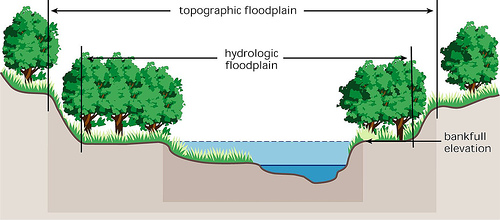Flooding in Wisconsin
Last week, residents of southern Wisconsin experienced the first flash flood warnings of 2016. Flash floods are not prolific in Wisconsin, but they can be detrimental and have been in the past. One of the most significant floods in Wisconsin in recent years was in 2008. This flood caused 40,000 homes and 5,000 businesses to become severely damaged in southern Wisconsin. The total damage was estimated to cost more than $1.2 billion (Flood Safety). Although severe floods are not common in Wisconsin, flooding is common in southern Wisconsin due to the topography.
Madison, Wisconsin - and many cities around it – are located near lakes. Lakes are located in low topographic land and they receive all of the watershed from the rivers, streams, and creeks around it. When it rains, rainfall travels from the ground to the rivers, streams, creeks, etc, to the lakes in the lowland. Wisconsin has an average of 30.89 inches of rainfall per year; this is not a drastic amount in comparison to rainy states such as Florida, whom receives 49.91 inches per year. However, there is still risk for flooding and those who live near lakes in South Central Wisconsin are at a greater risk than other residents of Wisconsin. (See here for more information about Wisconsin floods)!

Plan for Flooding
Steps to take when it floods
The most obvious reason why flooding is devastating to many families is because it damages their home. During a flood, it is important to get to higher ground because more than likely flooding will occur in a basement. Purchasing flood insurance is important and having a plan before flooding actually happens is even more important. Moving your valuables, furniture, and important documents to a safe place is suggested by the government and needs to be done before valuables are ruined from water.

After flooding has occurred, getting the water out of your house and making sure your valuables have not been harmed should be your number one priority. Basement flooding is typical and, unfortunately, basements are used often for a place to store an individuals possessions. Moving all of the items out of your basement can be a pain and finding a place to put them while a professional drains your basement is even more cumbersome. That is why finding temporary storage is a must after flooding.

There are many steps one must take after a flood and you can find out what to do from a government sponsored website. Preventing mold growth in your house should be your number one priority during and after a flood. How mold grows and how to prevent mold is explained in this blog. Utilizing temporary storage for valuables while you clean the problem should also be on your agenda. Cleaning and drying your items before you store them is important because it will prevent mold growth on your possessions and decrease the risk for further damage.

Takeaway Message
Flooded basements are a recurring nightmare for homeowners in south central Wisconsin, particularly those near Madison's chain of lakes. This vulnerability stems from the region's low-lying topography, where the Yahara River's path contributes to frequent flooding. When disaster strikes, documenting damaged possessions is crucial for insurance claims, often requiring a meticulous inventory with photos or videos of each item. However, the challenge then becomes where to store these salvaged goods. A humid Wisconsin garage in the summer is a recipe for disaster, as it can easily lead to mold growth and further damage. Renting a climate-controlled storage unit offers a far superior solution, providing not only protection from the elements but also security and convenient access while homeowners assess the damage and begin the long process of recovery. See here for temporary storage options.

